Installing Raymarine i70 and p70 displays
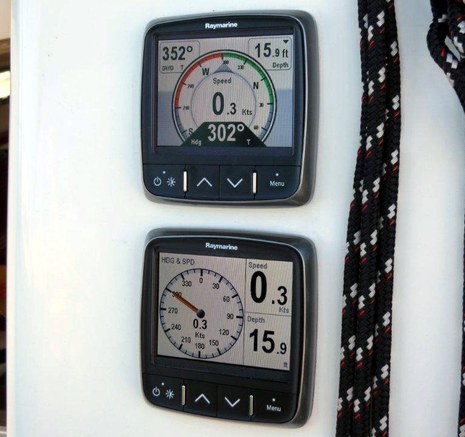
Thanks to Dan Corcoran for submitting a valuable Panbo install entry while your regular editor slacks off ~ Ben:
While the ST70+ -- which I wrote about here -- continues as the largest and most readable of Raymarine's many instrument displays, the svelt i70 and its sibling p70 autopilot control heads may be the right size and price to be easy replacements for your existing displays, as they were on my sailboat Breeze Pleeze. As shown in the picture below, the new i70 can drop into the same hole as an ST60 or ST70 with re-positioned mounting screws ready to grab into fresh fiberglass. The display can also be installed in territory previously out of reach, such as shallow cavities that lack good rear access, with a new "front mounted design for simpler installation". The physical installation is done by securing the display from the front with self tapping screws in each corner that are hidden behind a slim silver snap-on bezel seen two pictures below.
There are three models in the series, including two auto pilot controllers tailored differently for sailboats (p70) vs. power boats (p70r). The two autopilot controllers can display an astounding 8 data values including 6 you choose plus heading and rudder position, while the non-autopilot version (i70) displays up to 6 values in larger size text and with more graphics options due to the increased screen size possible with autopilot buttons and knobs absent.
It is extremely easy to swap out an ST6001 control head in 30 minutes or less. I could have done it in 15 if I wasn't taking pictures or pausing to write down the autopilot configuration from the ST6001 head. That proved unnecessary as the autopilot configuration is stored in the S1G autopilot and need not be reconfigured in the p70. Configuration required only choosing US measurements, sailboat type, and skipping past the success message. Part of the swap being so easy, is that I just plugged this display into the original Seatalk wiring to the S1G autopilot. In total, the installation involved removing the existing display, lining up the new display, marking and drilling 4 holes, plugging into Seatalk (requires Seatalk adapter A06047 and 3 way block D244 purchased separately), screwing the display into the panel, and answering two configuration questions. Done.
As you might have guessed the displays are designed for NMEA-2000/STng networking. Using the i70 with plain old Seatalk is possible because of conversion capabilities built into the display and an extra signal lead in STng spur cable wiring.
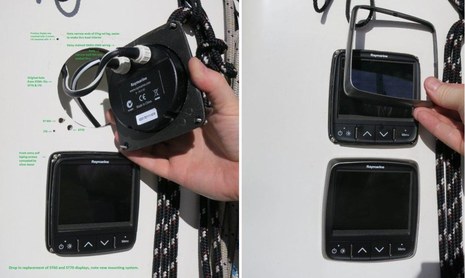
The displays feature two STng connectors that is perhaps still considered outlaw by the NMEA but is handy for daisy chaining multiple displays. I use this feature a lot, combining easy-to-snake Raymarine spur cables with the Maretron "MID" size backbone cable I wrote about in 2009 using the STng DeviceNet male adaptor cable A06046 that's now easy to find (though the descriptions of male and female adapters is confusing). That contributed mightily to the quick installation time I experienced despite my mixed network cabling.
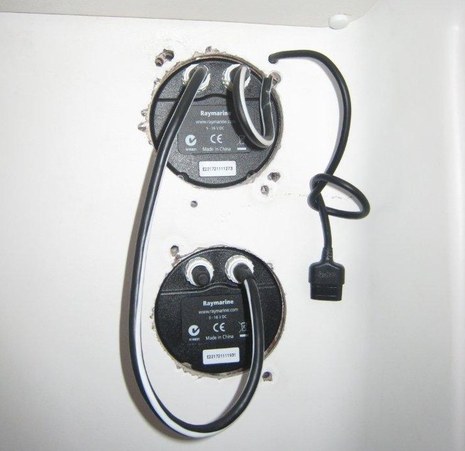
More about N2K: Replacing ST60 primary instrument displays with i70's is a bit more involved without transducer inputs on the i70 like the ST60 Tridata has. Existing Raymarine sensors need to be wired to a iTC-5 instrument transducer, which puts their data onto the N2K bus and via which from which any ST70, ST70+, or i70 display can calibrate them (e.g. set depth, etc.). Or, if you retain SeaTalk displays somewhere on the boat, you can use an adapter cable to get the data to an i70 or an ST-to-STng converter (tested here on Panbo) to get it onto a whole backbone of displays. If you have transducers from Maretron or Airmar that plug directly into the STng network, that is also an option (and Raymarine will likely introduce native STng sensors eventually). If you have multiple N2K transducers you can choose which to use.
The benefit of upgrading the autopilot controller is in all the extra data you can view with the far higher resolution display of the p70/p70r vs. its predecessors.There are numerous great options offered in displaying boat data in addition to heading and rudder position, and one of the buttons is programmable to be either TRACK or WIND VANE. I hope to submit a feature request for that button to choose between apparent vs true wind vane, an option deep in another menu that would be ideal here.
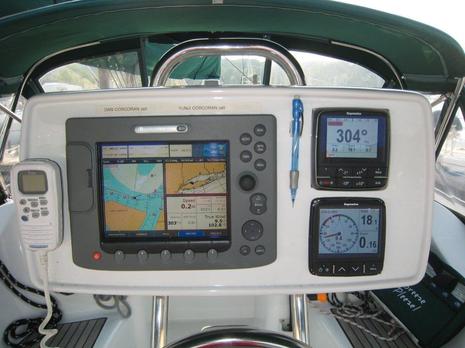
Installing i70's as additional displays or refitting ST60 repeater instrument displays is similarly easy but with different benefits. As with the color ST70 and ST70 plus displays before it, the i70's provide a very configurable way to view lots of data on the boat the way you want it. For a sailboat guy like me that wants different information depending on how I am using the boat, I take advantage that each display can have many different views especially for the non-autopilot displays.
I hope you don't take offense, but if you (the reader) are at my helm, I would toggle the i70's at my companionway to show depth and heading, and maybe AIS. If I am at the helm, the companion way would instead show information based on how I am using the boat today. I might put up information my daughter would like (time to waypoint / are we there yet). With my crew or myself trimming the sails, the displays are set to enable our boat to sing out loud how well the wind and boat are playing off each other, as the crew and I seek to be one with nature.
Sing out loud? Yes really, read here how these instrument displays make boat information like music to my ears!
Choosing STng over Seatalk in an i70 installation has the added benefit that the brightness on all the ST70, ST70+ and i70 displays will be synced and adjustable from one display in 100 tiny increments. This comes in handy at sunset as in this picture where all four instrument clusters on Breeze Pleeze may be adjusted together as many as three times during sunset.
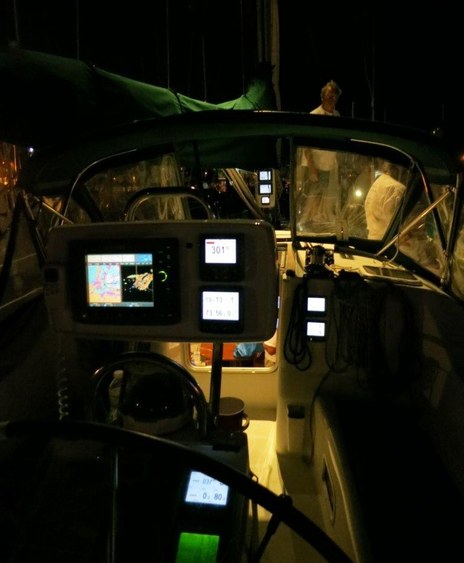
- Dan Corcoran is an avid sailor and leads ServiceSPAN a back office work center automation technology company.

 Share
Share
Dan
Great article, Thanks for the insight.
Defiantly the best dials on the market, I love the way they look and work. Had a really good play with them at the southampton boat show. i even like the i50 & i60.
Have not installed them myself yet, but its a job for the winter when the boat gets lifted out for winter!